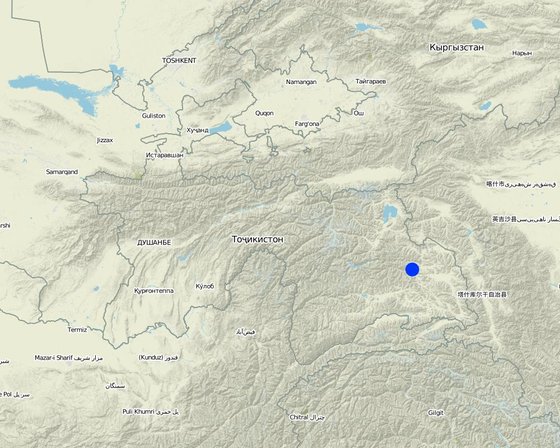

На Восточном Памирме имеется более 1 млн. га пастбищных угодий однако они малопродуктивны, что отрицательно сказывается на развитие животноводство в этом районе. В Советское время широко использовались отдаленные пастбища поэтому и их ротация в течение года, что способстововало рациональному использованию пастбищных угодий. В последние годы из за нарушения пастбищеоборота близко расположенные пастбища сильно деградированы. Технология предусматривает возможность рационального использования близко расположенных пастбищ путем перекачки скота 2-3 раза по каждому ущелью с промежутками в 30 дней. При этом необходимо соблюдать норму содержание скота в каждой отаре и их размешать в каждом пастбище и перекачивать с учетом емкости пастбища
Назначение технологии: Предотвращение процессов опустынивания и эрозии почвы пастбищных угодий.
Основные действия и вложения: Особенность технологии заключается в том, что для каждого фермера отводится определенная площадь, где определяется продуктивность пастбища, питательная ценность произрастающих там кормовых растений, а также определяется емкость площади. С учетом емкости пастбища на этой площади размещают определенное количество скота на определенный период. После истечения срока скот перегоняют на расположенные сверху пастбища, продолжая этот процесс до конца осени. Через 50-60 дней перекачки скота травостой достигает определенной высоты и доступен для стравливания скотом. На каждом пастбищном участке ежегодно проводят оборот пастбища с учетом их визуального состояния
Природная\социальная обстановка: Жесткие климатические условия, долгая зима, но малоснежная, лето короткое и прохладное. Среднегодовая температура воздуха от -1 до -4,3*С. Почвенный покров - высокогорный, пустынный. Население занимается исключительно скотоводством. Численность населения 14 тыс. Безработица более 60 %.

Location: Мургаб, ГБАО, Tajikistan
No. of Technology sites analysed:
Spread of the Technology:
Date of implementation: less than 10 years ago (recently)
Type of introduction



Technical specificationsМесто расположения: Мургаб. ГБАО
Дата: 20 июля 2010 Необходимые технические навыки для работников: средний Необходимые технические навыки для землепользователей: низкий Основные технические функции: улучшение земляного покрова, содействие росту видов и сортов растительности (качество, например поедаемые кормовые культуры) |
|||||||||||
| Specify input | Unit | Quantity | Costs per Unit (US Dollars) | Total costs per input (US Dollars) | % of costs borne by land users |
| Labour | |||||
| труд | га | 1.0 | 100.0 | 100.0 | 100.0 |
| Equipment | |||||
| Инструменты | га | 1.0 | 50.0 | 50.0 | 50.0 |
| Total costs for establishment of the Technology | 150.0 | ||||
Quantity before SLM: 0,05
Quantity after SLM: 1,3 т/га
Quantity before SLM: 5%
Quantity after SLM: 50%
Quantity before SLM: 20%
Quantity after SLM: 40%